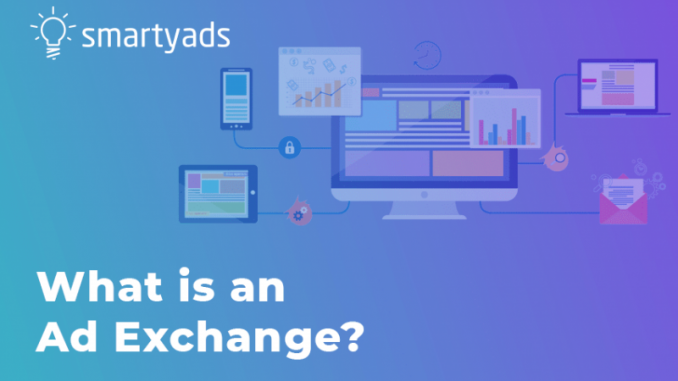
As you navigate the vast landscape of digital advertising, you might have come across the term “ad exchange.” But what exactly does it mean? In this article, we will delve into the world of ad exchanges, unraveling their significance and shedding light on their role in the digital advertising ecosystem.
A. What is an ad exchange?

Imagine an ad exchange as a bustling marketplace for buying and selling digital ad space. It acts as a virtual trading platform, connecting advertisers, publishers, and other key players in the advertising industry. Ad exchanges facilitate the automated buying and selling of ad inventory, enabling advertisers to reach their target audience across various websites and apps.
B. Importance of understanding ad exchanges in digital advertising
In today’s digital era, where traditional advertising methods are gradually losing their effectiveness, understanding ad exchanges becomes crucial for marketers, publishers, and advertisers alike. By comprehending the intricacies of ad exchanges, you gain a competitive edge and the ability to optimize your ad campaigns, ultimately driving better results and maximizing your return on investment (ROI).
Ad exchanges have revolutionized the way digital advertising operates, introducing programmatic advertising and real-time bidding (RTB) to the forefront. By harnessing the power of ad exchanges, advertisers can precisely target their desired audience, delivering relevant ads at the right time and place. Publishers, on the other hand, can monetize their ad space efficiently, optimizing revenue generation.
In the following sections, we will explore the definition and function of ad exchanges, identify the key players involved, highlight the benefits they offer, and address the challenges they face. So, let’s dive deeper into the world of ad exchanges and uncover the driving force behind successful digital advertising.
Stay tuned for the next section, where we will demystify the definition and function of ad exchanges, shedding light on how they work and their role in programmatic advertising.
Definition and Function of an Ad Exchange

A. Definition of an ad exchange
To truly grasp the concept of an ad exchange, we must first understand its definition. An ad exchange can be described as a digital marketplace where advertisers and publishers come together to buy and sell ad inventory in an automated and real-time environment. It serves as the intermediary platform that facilitates the transaction between advertisers looking to display their ads and publishers offering ad space on their websites or apps.
B. How ad exchanges work
Now that we have a basic understanding of what an ad exchange is, let’s explore how it operates. Ad exchanges leverage sophisticated technology to connect multiple ad networks, demand-side platforms (DSPs), and supply-side platforms (SSPs). When a user visits a website or app, information about that user, such as demographics, interests, and browsing behavior, is collected and anonymized. This valuable data is then made available to advertisers through the ad exchange.
Advertisers can specify their target audience by setting parameters such as location, age, interests, and more. The ad exchange then matches the available ad inventory with the most relevant ad based on these targeting criteria. This process happens in real-time, enabling advertisers to bid on the available ad space through real-time bidding (RTB).
C. Role of ad exchanges in programmatic advertising
Ad exchanges play a pivotal role in programmatic advertising, a method that automates the buying and selling of digital ads. Programmatic advertising relies on the technology and infrastructure provided by ad exchanges to streamline the entire ad buying process. It enables advertisers to reach their desired audience with precision and efficiency, optimizing their ad spend and campaign performance.
By utilizing ad exchanges, advertisers gain access to a vast network of publishers and ad inventory, expanding their reach and improving their chances of engaging with their target audience. Ad exchanges also provide transparency and control, allowing advertisers to monitor and adjust their campaigns in real-time, ensuring that their ads are displayed in the most effective and relevant contexts.
In the next section, we will explore the key players involved in ad exchanges, including publishers, advertisers, ad networks, DSPs, and SSPs. Stay tuned as we unravel the intricate web of ad exchange dynamics and their collective contribution to the digital advertising ecosystem.
Key Players in Ad Exchanges

When it comes to the world of ad exchanges, several key players collaborate to ensure seamless transactions and successful digital advertising campaigns. Let’s take a closer look at these essential stakeholders:
A. Publishers
Publishers play a vital role in the ad exchange ecosystem. They own and operate websites, apps, or other digital platforms where ad space is available. Publishers offer this ad inventory to advertisers through ad exchanges, generating revenue by allowing ads to be displayed on their platforms. By partnering with ad exchanges, publishers gain access to a wide range of advertisers, maximizing their chances of monetizing their ad space effectively.
B. Advertisers
Advertisers are the brands, businesses, or individuals seeking to promote their products or services through digital advertising. They rely on ad exchanges to reach their target audience efficiently. Advertisers can leverage the vast network of publishers available on ad exchanges to display their ads across various online platforms. By utilizing ad exchanges, advertisers can optimize their targeting capabilities, ensuring their ads are seen by the right users at the right time.
C. Ad networks
Ad networks act as intermediaries between advertisers and publishers. They aggregate ad inventory from multiple publishers and offer it to advertisers through ad exchanges. Ad networks simplify the process of buying and selling ad space by providing a consolidated marketplace for advertisers to access a wide range of publishers. By partnering with ad networks, advertisers can reach a broader audience while publishers can access a larger pool of potential buyers.
D. Demand-side platforms (DSPs)
Demand-side platforms (DSPs) are technology platforms that empower advertisers to manage and optimize their ad campaigns across multiple ad exchanges. DSPs provide advertisers with advanced targeting options, real-time bidding capabilities, and sophisticated analytics to enhance campaign performance. By leveraging DSPs, advertisers can effectively reach their desired audience, optimize their ad spend, and achieve their marketing objectives.
E. Supply-side platforms (SSPs)
Supply-side platforms (SSPs) are technology platforms used by publishers to manage and sell their ad inventory across various ad exchanges. SSPs enable publishers to access a wide range of demand sources, including ad networks, DSPs, and direct advertisers. By utilizing SSPs, publishers can maximize their revenue potential by efficiently managing and optimizing the sale of their ad space.
Understanding the roles of these key players is essential in navigating the complex world of ad exchanges. In the next section, we will explore the benefits of using ad exchanges, shedding light on the advantages they offer to both advertisers and publishers. Stay tuned!
Benefits of Using Ad Exchanges

Ad exchanges bring forth a multitude of benefits for both advertisers and publishers, revolutionizing the way digital advertising operates. Let’s explore some key advantages that make ad exchanges an indispensable tool in the advertising realm.
A. Increased transparency in ad buying and selling
In the traditional advertising landscape, transparency was often elusive, leaving advertisers uncertain about where their ads would be displayed and how their budget was being utilized. Ad exchanges address this concern by providing transparency in the buying and selling process. Advertisers have access to detailed information about the ad space they are purchasing, including the website or app on which their ads will appear. This transparency empowers advertisers to make informed decisions, ensuring their ads are displayed in suitable environments that align with their brand values.
B. Enhanced targeting capabilities
One of the most significant advantages of ad exchanges is their ability to facilitate precise targeting. Through sophisticated algorithms and data analysis, ad exchanges enable advertisers to target specific demographics, interests, locations, and even behaviors. This level of granularity ensures that ads are delivered to the most relevant audience, increasing the chances of engagement and conversion. By leveraging ad exchanges’ targeting capabilities, advertisers can optimize their ad spend, focusing on users who are more likely to be interested in their products or services.
C. Real-time bidding (RTB) advantages
Ad exchanges operate on the foundation of real-time bidding (RTB), a dynamic auction-based system that allows advertisers to bid for ad space in real-time. This real-time bidding process ensures that advertisers have the opportunity to display their ads to the right audience at the right moment. RTB enables advertisers to bid on ad impressions individually, optimizing their bids based on user data and campaign performance. This flexibility and agility in bidding provide advertisers with the advantage of maximizing their ROI by allocating their budget to the most valuable impressions.
D. Cost-effectiveness and efficiency in ad campaigns
Ad exchanges offer a cost-effective and efficient solution for advertisers. Through real-time bidding, advertisers can determine the true value of each ad impression and bid accordingly, preventing overpayment for less valuable impressions. Additionally, the automation and streamlined processes in ad exchanges eliminate the need for manual ad placement negotiations, saving both time and resources. Ad exchanges allow advertisers to reach a vast network of publishers and audiences with ease, expanding their reach while optimizing their ad spend.
Stay tuned for the next section, where we will address the challenges and limitations that ad exchanges face in the digital advertising landscape.
Challenges and Limitations of Ad Exchanges

While ad exchanges offer numerous benefits, they are not without their fair share of challenges and limitations. In this section, we will explore some of the key obstacles that ad exchanges face and how they impact the digital advertising landscape.
A. Ad fraud and brand safety concerns
Ad fraud is a persistent issue that plagues the digital advertising industry. Fraudulent activities such as bot traffic, click fraud, and impression fraud can lead to wastage of ad budgets and undermine the credibility of ad exchanges. Additionally, brand safety concerns arise when ads are displayed alongside inappropriate or harmful content, tarnishing a brand’s reputation. Ad exchanges need to implement robust fraud detection and prevention measures to combat these challenges and ensure a safe and trustworthy advertising environment.
B. Ad viewability and ad fraud prevention
One of the challenges faced by ad exchanges is ensuring ad viewability. Advertisers want their ads to be seen by real users, but ad viewability can be compromised by factors such as ad placements, ad-blocking software, and fraudulent practices. Ad exchanges need to address these issues by monitoring ad viewability metrics, implementing viewability standards, and collaborating with industry organizations to establish guidelines that promote transparency and accountability.
C. Ad inventory quality control
Maintaining ad inventory quality is crucial for ad exchanges to provide a valuable and engaging experience for advertisers and users alike. Ad exchanges must ensure that the inventory they offer is authentic, relevant, and free from fraudulent or low-quality placements. Implementing stringent quality control measures, partnering with trusted publishers, and leveraging technology solutions can help mitigate the risks associated with ad inventory quality.
D. Ad-blocking software impact

The rise of ad-blocking software has posed a significant challenge for ad exchanges. Users who employ ad blockers prevent ads from being displayed, resulting in lost revenue for publishers and limited reach for advertisers. Ad exchanges need to explore alternative ad formats, such as native ads or non-intrusive ad experiences, to overcome this obstacle and deliver ads that align with users’ preferences.
In the next section, we will conclude our exploration of ad exchanges, summarizing the key points discussed and emphasizing the importance of leveraging ad exchanges for successful digital advertising.
